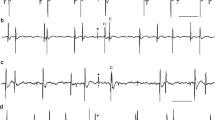Abstract
Non-monosynaptic group I and group II excitation of human lower limb motoneurones was investigated. Changes in the firing probability of individual voluntarily activated motor units belonging to various muscles (soleus, gastrocnemius medialis, tibialis anterior, peroneus brevis, quadriceps and biceps femoris) were investigated after stimulation of various nerves (posterior tibial, common peroneal and femoral nerves) with weak (0.4–0.6×motor threshold) electrical stimuli. In all investigated motor nuclei, stimulation of the ”homonymous” nerve evoked a peak of increased firing probability with a latency that was 3–7 ms longer than the monosynaptic Ia latency. The more caudal the motor nucleus explored, the greater the central delay. This strongly suggests a transmission through neurones located above the lumbar enlargement. If one excepts the sural-induced excitation of peroneus brevis units, which seems to be mediated through a particular pathway, the main peripheral input to neurones mediating non-monosynaptic excitation evoked by these weak stimuli is group I in origin. The pattern of distribution of non-monosynaptic group I excitation was very diffuse, since stimulation of each nerve was able to evoke excitation in all investigated nuclei. In most cases, non-monosynaptic excitation evoked in a given motor unit by stimulation of one nerve was depressed on combined stimulation of two nerves, and evidence is presented that this lateral inhibition is exerted at a premotoneuronal level. By contrast, there was no evidence that increasing the afferent input in a given pathway evokes an ”autogenetic” inhibition in this pathway. The negative correlation found between non-monosynaptic group I-induced and late group II-induced facilitation of the quadriceps H-reflex when using high stimulus intensities applied on the common peroneal nerve suggests that these two effects could be mediated through common interneurones.
Similar content being viewed by others
Author information
Authors and Affiliations
Additional information
Received: 21 June 1996 / Accepted: 9 December 1996
Rights and permissions
About this article
Cite this article
Chaix, Y., Marque, P., Meunier, S. et al. Further evidence for non-monoynaptic group I excitation of motoneurones in the human lower limb. Exp Brain Res 115, 35–46 (1997). https://doi.org/10.1007/PL00005683
Issue Date:
DOI: https://doi.org/10.1007/PL00005683




